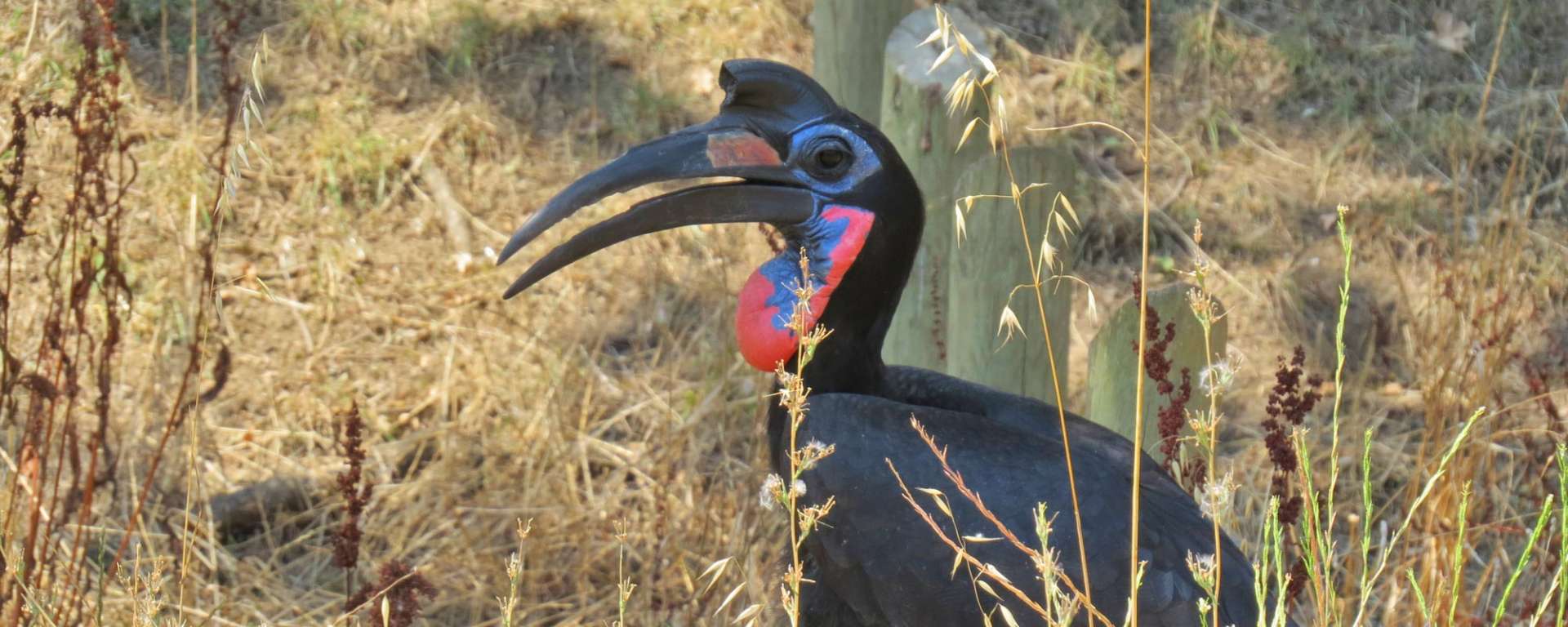Description
The Abyssinian ground hornbill (northern ground hornbill) is a very large hornbill. They are about 90-100 cm (about 37 inches) tall and the male weighs about 4000 g (about 8 pounds). The males and females both have a long straight black beak with a yellow patch on the top of the beak where it meets the face. They have a distinctive tall casque, an enlargement on the beak. The face skin of both male and female is bare of feathers and dark blue. The male has bare inflatable throat skin (a wattle) that is blue and red. The female’s wattle is blue, like her face. Both have black feathers and white primaries on the wings. Juveniles are browner than adults, with the patch on the beak a dull yellow, grey face skin and no casque.
Classification
- Class
- Aves
- Order
- Bucerotiformes
- Family
- Bucerotidae
- Genus
- Bucorvus
- Species
- B. abyssinicus
- Conservation Status
- Vulnerable
Key Facts
- Height
- 90-100 cm (about 37 inches)
- Weight
- ~4000 g (about 8 pounds)
The IUCN Red List classifies Bucorvus abyssinicus as Vulnerable. The global population is unknown but habitat loss and other factors have contributed to a steady decline in the population.
Social Life
Abyssinian (northern) ground hornbills are sedentary. They do not migrate. Juveniles remain in the parent home range for several years. They are diurnal, waking at first light.
Habitat and Range
Savanna and sub-desert scrubland in southern Mauritania and Guinea, eastern Ethiopia, northern Somalia, Kenya, and Uganda.
Diet
Abyssinian ground hornbills walk slowly across the ground in search of prey, which can be tortoises, lizards, frogs, snakes, insects, arthropods, and small mammals such as rats. They are mainly carnivorous, but will eat some seeds, nuts, and fruit. They typically forage in pairs, with 1 or 2 offspring.
Lifespan
About 40 years in captivity.
Predators
The young in particular are in danger from carnivores, snakes, and large birds.
Reproduction
Abyssinian ground hornbills form a pair bond.
Sexual Maturity: Approximately 3 years, although the distinctive color of the wattle begins to show at about 1 year.
Mating Season: Variable depending on geographic location. In captivity there is no specific breeding season.
Incubation: 37-41 days.
No. of Young: The female lays two eggs in a cavity in a large tree, often a baobab. The male supplies the nest with a lining of leaves. The eggs are laid 4-5 days apart. The female incubates the eggs and is fed at the nest by the male. When the chicks hatch they have pink skin, which turns black after about 10 days. The chick fledges at 80-90 days. After 21-33 days, the female leaves the nest periodically and helps the male feed the chick. If the first hatched chick thrives, the second hatched chick typically starves to death, in about 4 days.
- Information
-
Description
The Abyssinian ground hornbill (northern ground hornbill) is a very large hornbill. They are about 90-100 cm (about 37 inches) tall and the male weighs about 4000 g (about 8 pounds). The males and females both have a long straight black beak with a yellow patch on the top of the beak where it meets the face. They have a distinctive tall casque, an enlargement on the beak. The face skin of both male and female is bare of feathers and dark blue. The male has bare inflatable throat skin (a wattle) that is blue and red. The female’s wattle is blue, like her face. Both have black feathers and white primaries on the wings. Juveniles are browner than adults, with the patch on the beak a dull yellow, grey face skin and no casque.
Classification
- Class
- Aves
- Order
- Bucerotiformes
- Family
- Bucerotidae
- Genus
- Bucorvus
- Species
- B. abyssinicus
- Conservation Status
- Vulnerable
Key Facts
- Height
- 90-100 cm (about 37 inches)
- Weight
- ~4000 g (about 8 pounds)
- Conservation
The IUCN Red List classifies Bucorvus abyssinicus as Vulnerable. The global population is unknown but habitat loss and other factors have contributed to a steady decline in the population.
- Lifestyle
Social Life
Abyssinian (northern) ground hornbills are sedentary. They do not migrate. Juveniles remain in the parent home range for several years. They are diurnal, waking at first light.Habitat and Range
Savanna and sub-desert scrubland in southern Mauritania and Guinea, eastern Ethiopia, northern Somalia, Kenya, and Uganda.Diet
Abyssinian ground hornbills walk slowly across the ground in search of prey, which can be tortoises, lizards, frogs, snakes, insects, arthropods, and small mammals such as rats. They are mainly carnivorous, but will eat some seeds, nuts, and fruit. They typically forage in pairs, with 1 or 2 offspring.Lifespan
About 40 years in captivity.Predators
The young in particular are in danger from carnivores, snakes, and large birds.Reproduction
Abyssinian ground hornbills form a pair bond.
Sexual Maturity: Approximately 3 years, although the distinctive color of the wattle begins to show at about 1 year.
Mating Season: Variable depending on geographic location. In captivity there is no specific breeding season.
Incubation: 37-41 days.
No. of Young: The female lays two eggs in a cavity in a large tree, often a baobab. The male supplies the nest with a lining of leaves. The eggs are laid 4-5 days apart. The female incubates the eggs and is fed at the nest by the male. When the chicks hatch they have pink skin, which turns black after about 10 days. The chick fledges at 80-90 days. After 21-33 days, the female leaves the nest periodically and helps the male feed the chick. If the first hatched chick thrives, the second hatched chick typically starves to death, in about 4 days.

